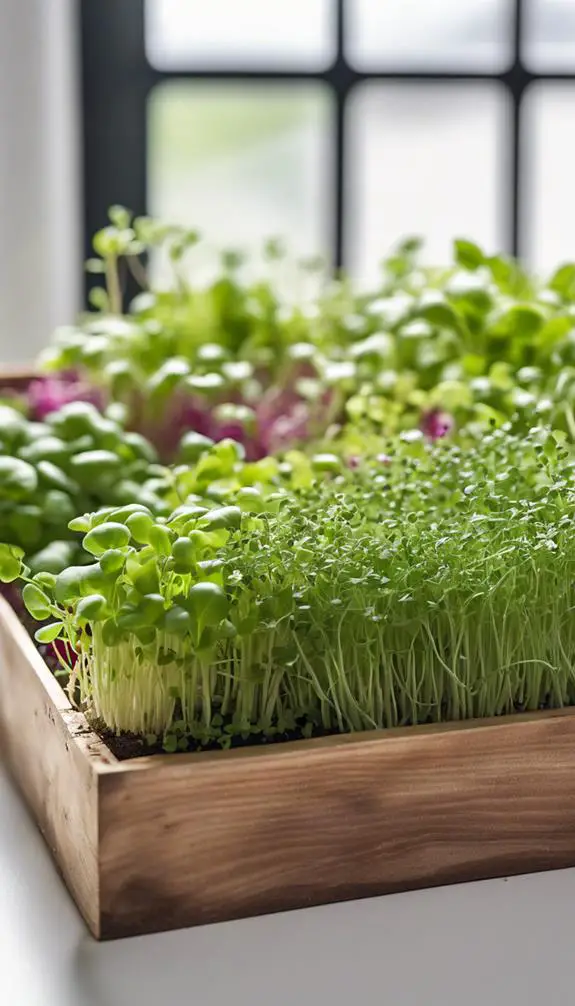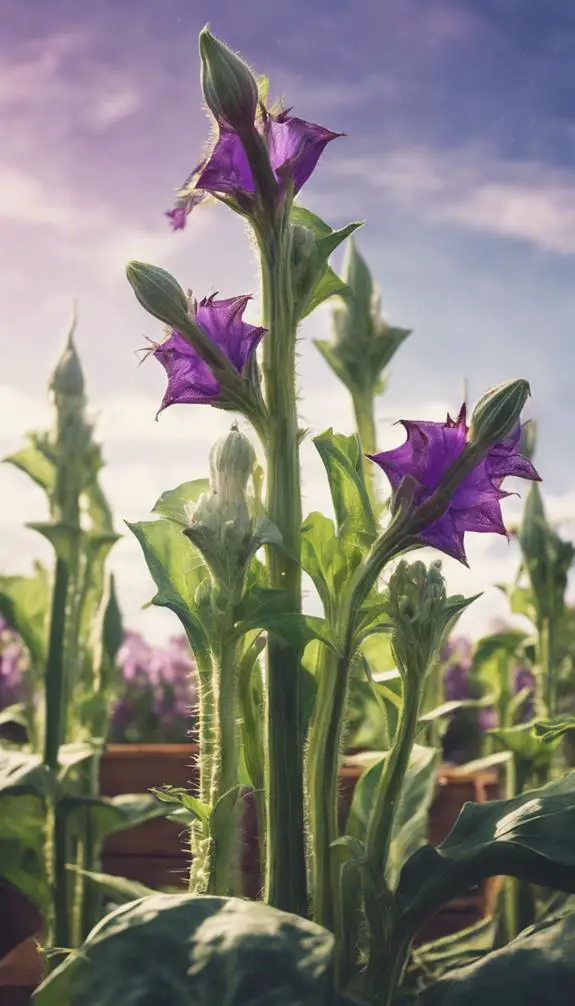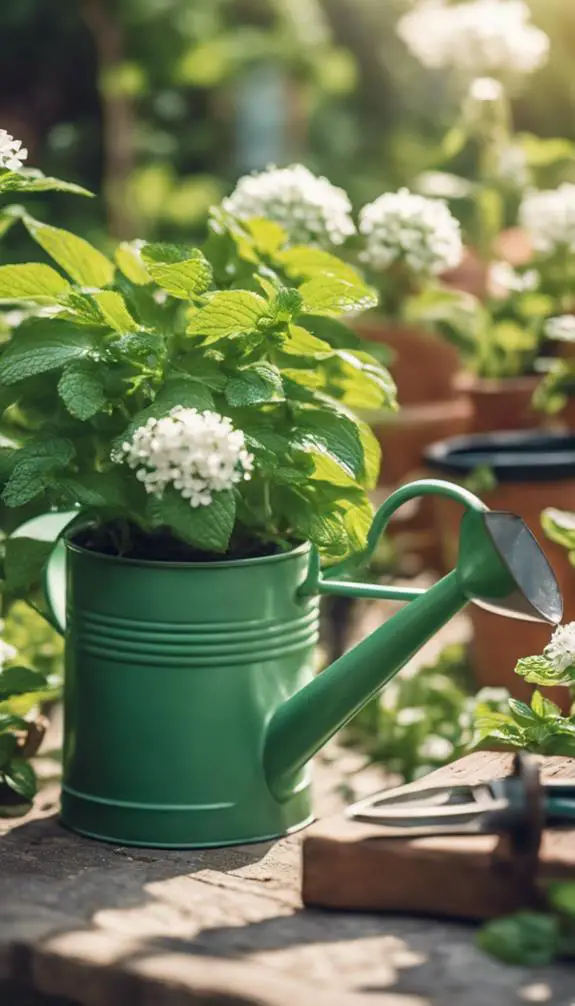You're about to reveal the secrets to growing lush, fragrant mint plants that will elevate your cooking and herbal remedies. First, you'll need to choose the right mint variety for your needs – peppermint, spearmint, or chocolate mint are popular options. But before you can start harvesting fresh leaves, you'll need to prepare the perfect soil and get your hands on healthy mint plants. What's the best way to guarantee your mint thrives, and what common mistakes should you avoid? Let's explore the world of mint cultivation and discover the tips and tricks to make your mint plants flourish.
Summary
- Select a healthy mint plant with bright green leaves and sturdy stems from a reputable nursery or online supplier.
- Plant mint in well-balanced soil with good drainage and aeration, and a pH between 6.0 and 7.0 for optimal growth.
- Water mint consistently, providing about 1-2 inches of water per week, and avoid overwatering to prevent root rot.
- Prune mint regularly to promote bushy growth, prevent overcrowding, and encourage a compact shape.
- Provide mint with partial shade to full sun, with at least 4-6 hours of direct sunlight, and fertilize during the growing season.
Choosing the Right Mint Variety
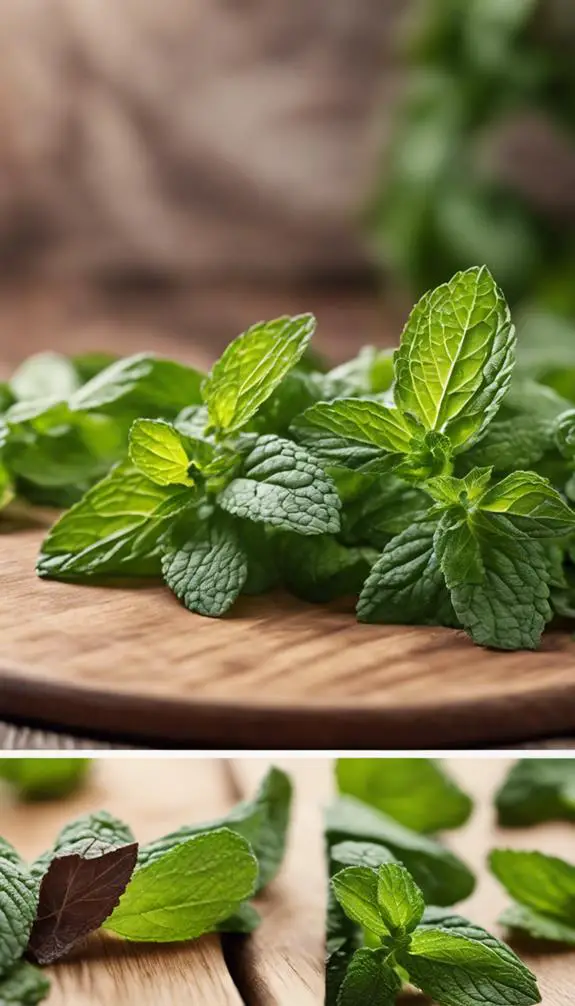
When it comes to growing mint, picking the right variety is key to guaranteeing you get the desired flavor, aroma, and growth habits.
With over 600 varieties to choose from, you'll want to select one that suits your needs.
If you're looking for a classic peppermint flavor, opt for 'Peppermint' or 'Chocolate Mint' for a twist.
For a fruity twist, try 'Strawberry Mint' or 'Pineapple Mint'.
Fragrant varieties like 'Spearmint' and 'Apple Mint' are ideal for teas and potpourri.
If you're looking for a more subtle flavor, 'Corsican Mint' is a great choice.
Research the specific mint flavors and growth habits you want, and choose a variety that fits your goals.
This will guarantee you get the most out of your mint plants and enjoy the benefits they've to offer.
Preparing the Soil for Planting

When preparing the soil for mint, you'll want to guarantee it has a well-balanced structure that allows for good drainage and aeration.
Mint thrives in soil with a pH between 6.0 and 7.0, so you may need to adjust your soil's acidity level accordingly.
Additionally, incorporating organic matter like compost or peat moss will help retain moisture and provide a nutrient-rich environment for your mint plants to grow.
Soil Structure Matters
Mint's vigorous growth and hardiness can sometimes belie its need for a well-prepared soil foundation.
However, mint tolerance to poor soil conditions doesn't mean you can neglect soil preparation. You'll want to create a well-draining soil structure that allows for adequate soil aeration, which mint roots need to thrive.
To achieve this, mix in organic matter like compost or well-rotted manure to break up clay soils or improve sandy soils' water-holding capacity. Avoid compacting the soil, as this can hinder root growth and reduce soil aeration.
Mint's Ideal Ph Level
In regard to pH, mint plants thrive in slightly acidic to neutral soils, with an ideal pH range of 6.0 to 7.0.
This allows the mint to absorb essential nutrients without being hindered by excessive acidity or alkalinity. You'll want to avoid soils with high alkalinity, as this can lead to nutrient deficiencies and stunted growth.
Conversely, mint acidity can be beneficial, as it promotes healthy root development and increases the plant's resistance to disease.
To achieve the ideal pH range, you can mix in organic matter like compost or peat moss to lower the soil's pH. Alternatively, you can add lime to raise the pH if your soil is too acidic.
Moisture Retention Tips
You'll need to prepare the soil to retain moisture effectively, a crucial step in growing healthy mint plants.
To achieve this, create humid microclimates by incorporating organic matter like compost or well-rotted manure into the soil. This will improve its water-holding capacity, allowing mint roots to access moisture as needed.
Apply a 2-3 inch layer of organic mulch, such as straw or bark chips, around the plants. This will reduce evaporation and retain soil moisture.
As you add mulch layers, verify they're porous to prevent waterlogging. By following these moisture retention tips, you'll provide your mint plants with the ideal conditions to thrive.
Obtaining Healthy Mint Plants

Select a reputable nursery or online supplier to source healthy mint plants, as this is crucial for a thriving crop.
You'll want to choose mint plants with bright green leaves and sturdy stems. Avoid plants with yellow or wilted leaves, as they may be stressed or diseased.
Mint nurseries typically offer a variety of mint species, such as peppermint, spearmint, and chocolate mint.
Online suppliers often provide detailed product descriptions and customer reviews to help you make an informed decision.
When purchasing online, verify the supplier has a good reputation and provides healthy, disease-free plants.
Planting Mint in Containers
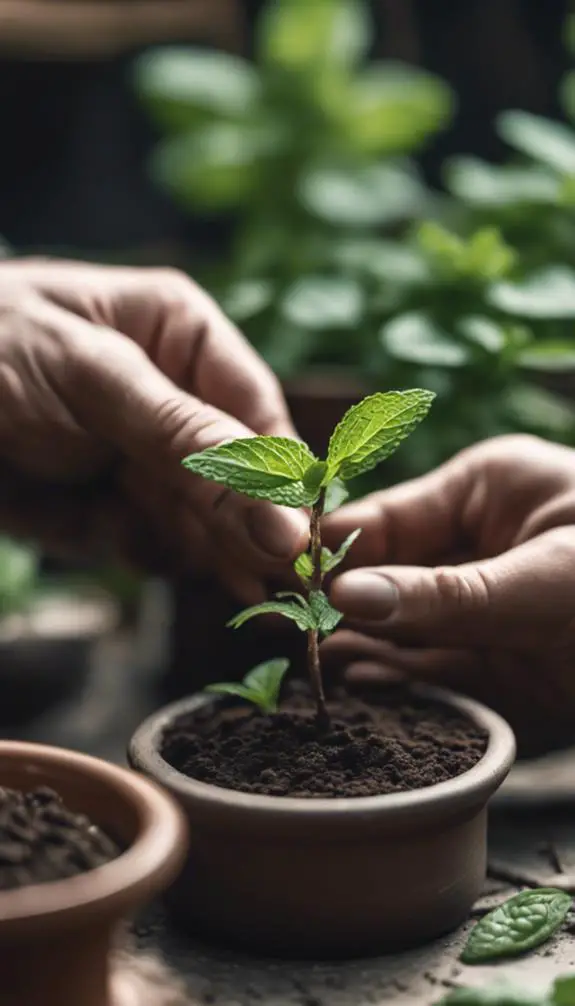
Now that you've sourced healthy mint plants, it's time to give them a suitable home.
When planting mint in containers, choose a pot that's at least 6-8 inches deep to accommodate the plant's vigorous growth.
Select a container with good drainage holes to prevent waterlogged soil, which can lead to root rot.
Mint overgrowth can be a problem, so consider using a container that's wide enough to allow for pruning and containment.
A mix of potting soil and perlite or vermiculite will provide adequate drainage and aeration for the roots.
Plant the mint at the same depth as it was in the nursery, and water gently but thoroughly.
Caring for Newly Planted Mint

You'll need to pay close attention to your newly planted mint's soil and water needs, as it requires consistent moisture and well-draining soil to thrive.
To promote healthy growth and prevent overcrowding, you'll also need to prune your mint plant regularly, removing any dead or damaged leaves and stems.
Soil and Water Needs
Three key factors contribute to mint's soil preferences: good drainage, aeration, and a slightly acidic pH.
You'll want to certify your soil has these characteristics to promote healthy growth. Conduct a soil test to determine your soil's pH level and nutrient composition.
Based on the results, adjust the pH and add organic matter like compost or manure to improve aeration and drainage.
When it comes to watering, mint requires consistent moisture, especially during hot weather. However, overwatering can be detrimental, so practice water conservation by checking the soil daily and only watering when necessary.
Aim to provide about 1-2 inches of water per week, either through rainfall or irrigation.
Mint Plant Pruning Tips
How do you keep your newly planted mint from becoming leggy and unruly?
You need to prune it regularly to maintain its shape and promote healthy growth. Pinching techniques are essential in mint shaping.
Pinch off the tips of your mint plant when it reaches 6-8 inches tall to encourage branching. This will create a fuller plant with more leaves.
You can also trim back long stems to the first set of leaves to maintain a bushy shape. Regular pruning will help prevent your mint from flowering, which can reduce its flavor and aroma.
Sunlight and Temperature
Now that you've pruned your mint plant to perfection, it's time to focus on providing ideal growing conditions.
Mint thrives in partial shade to full sun, so choose a spot that receives direct sunlight for at least 4-6 hours a day. Summer sun can be intense, so guarantee your mint plant receives morning warmth and is protected from harsh afternoon rays.
As for temperature, mint prefers cooler temperatures between 60-75°F (15-24°C), making it an ideal crop for spring and fall. Avoid temperatures above 90°F (32°C), as this can lead to leaf scorch and reduced growth.
Providing Optimal Light Conditions

Located in a spot receiving bright, indirect light, your mint plant will thrive, as direct sunlight can cause scorching of the leaves and roots.
When it comes to mint placement, consider east- or west-facing windows, which provide ideal natural lighting conditions.
If you're growing mint indoors, position the plant near a window with a sheer curtain to filter the sun's intense rays.
Avoid placing mint in full shade, as it may lead to weak and leggy growth.
Watering Mint Plants Correctly
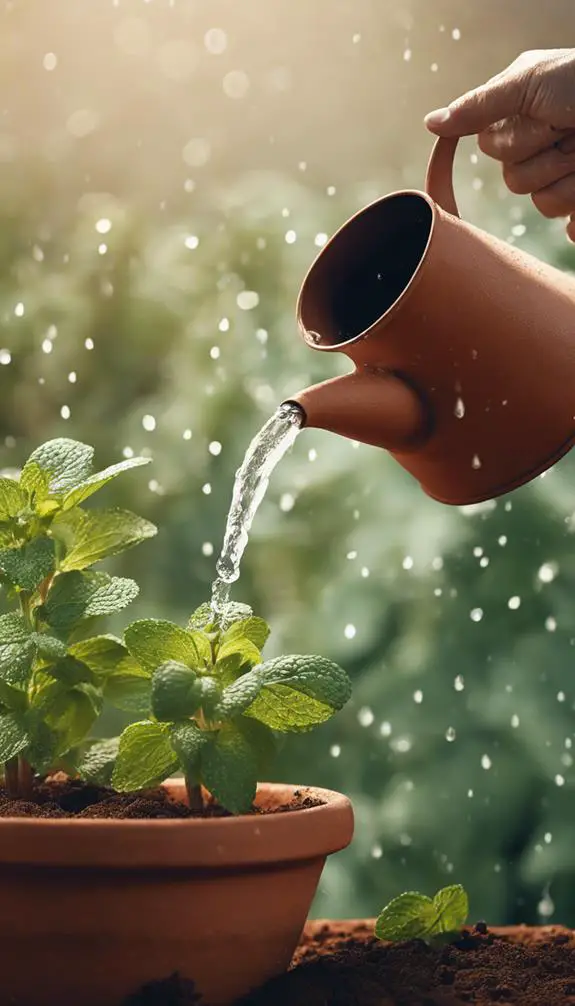
You'll want to establish a consistent mint watering schedule to guarantee your plants receive the right amount of moisture.
Check the soil daily, and water your mint when the top inch of soil feels dry to the touch, as mint prefers moist soil but can be susceptible to root rot if it's too wet.
Mint Watering Schedule
About every three to five days, mint plants require a good soaking to maintain ideal moisture levels, as they thrive in consistently moist soil.
You'll want to adjust this mint frequency based on factors like temperature, humidity, and light exposure. In warmer climates or during heatwaves, you may need to water every two days. Conversely, in cooler or shadier conditions, you can stretch water intervals to every seven days.
Aim to provide about 1-2 inches of water per session, ensuring the top 2-3 inches of soil feel moist but not waterlogged. By adhering to this mint watering schedule, you'll promote healthy growth and prevent issues like root rot.
Mint Soil Moisture Levels
When checking mint soil moisture levels, insert your finger into the soil up to the second knuckle, feeling for dampness or dryness, and then adjust your watering schedule accordingly.
This manual method allows you to gauge the moisture level, but for more precise mint monitoring, consider investing in soil sensors.
These devices provide real-time data on soil moisture, ensuring you're not over- or under-watering your mint plants.
By combining manual checks with sensor data, you'll achieve ideal soil moisture levels, promoting healthy growth and preventing root rot.
Regularly review your mint soil moisture levels to fine-tune your watering schedule, and your plants will thrive as a result.
Fertilizing Mint for Optimal Growth
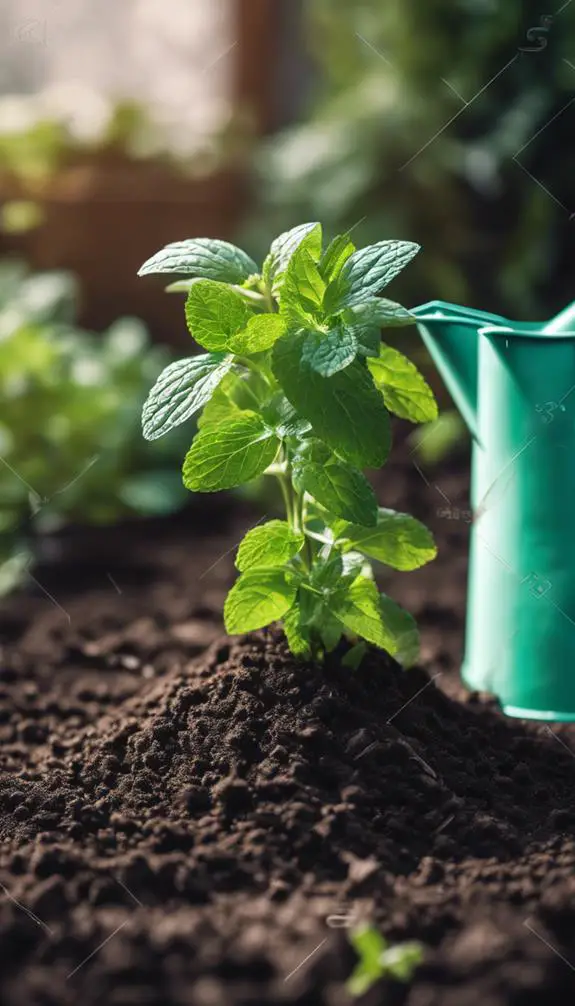
A nutrient-rich soil foundation is crucial for mint's vigorous growth and aromatic flavor.
You'll want to provide your mint plants with essential mint nutrients, such as nitrogen, phosphorus, and potassium, to promote healthy development.
When it comes to fertilizer timing, you should fertilize your mint plants during the growing season, typically in the spring and summer months.
A balanced, water-soluble fertilizer applied at a rate of 10-10-10 (nitrogen-phosphorus-potassium) will provide your mint plants with the necessary nutrients for peak growth.
Be cautious not to overfertilize, as this can lead to weak growth and reduced flavor.
Pruning Mint to Encourage Growth
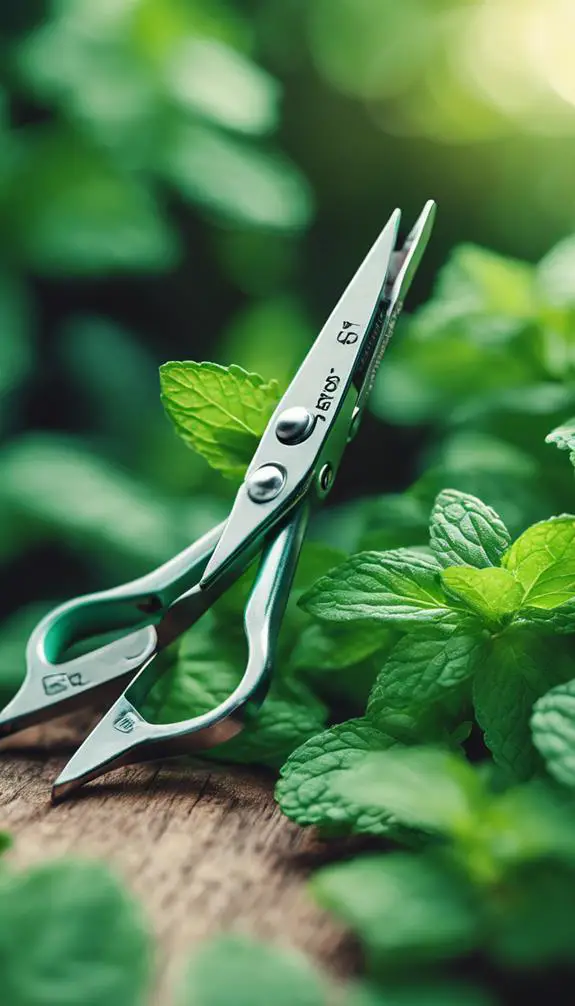
Your mint plants' stems, once leggy and sprawling, can be tamed with regular pruning to promote bushy growth and prevent them from becoming invasive.
Pinch off the top sets of leaves to encourage branching, and trim back long stems to about one-third of their height. This will help maintain a compact mint shape and promote new growth.
Establish a pruning schedule to guarantee your mint stays healthy and under control. Prune your mint every 6-8 weeks, or when you notice it getting leggy. By doing so, you'll encourage a bushy, dense growth habit and prevent your mint from taking over your garden.
Managing Pests and Diseases
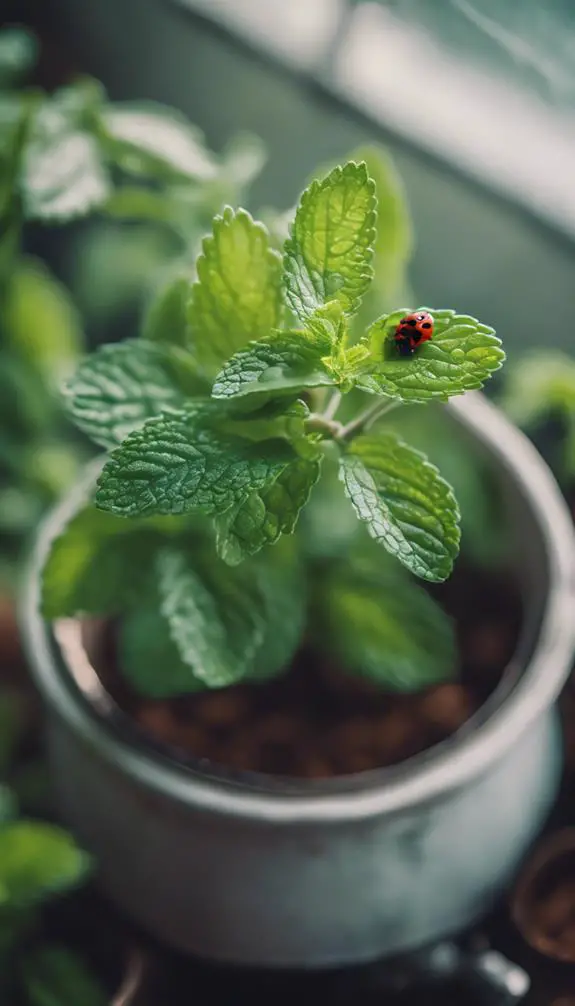
Three common pests that can wreak havoc on your mint plants are aphids, spider mites, and whiteflies.
These pests can cause significant damage, leading to stunted growth and reduced yields. To manage these pests, you'll need to employ effective pest control methods.
Natural pesticides, such as neem oil and pyrethrin, can be used to control infestations. Spray these pesticides directly on the affected areas to kill the pests.
For more severe infestations, introduce natural predators like ladybugs or lacewings to prey on the pests.
Regularly inspect your plants for signs of pests and take action promptly to prevent the infestation from spreading.
Propagating Mint Through Cuttings
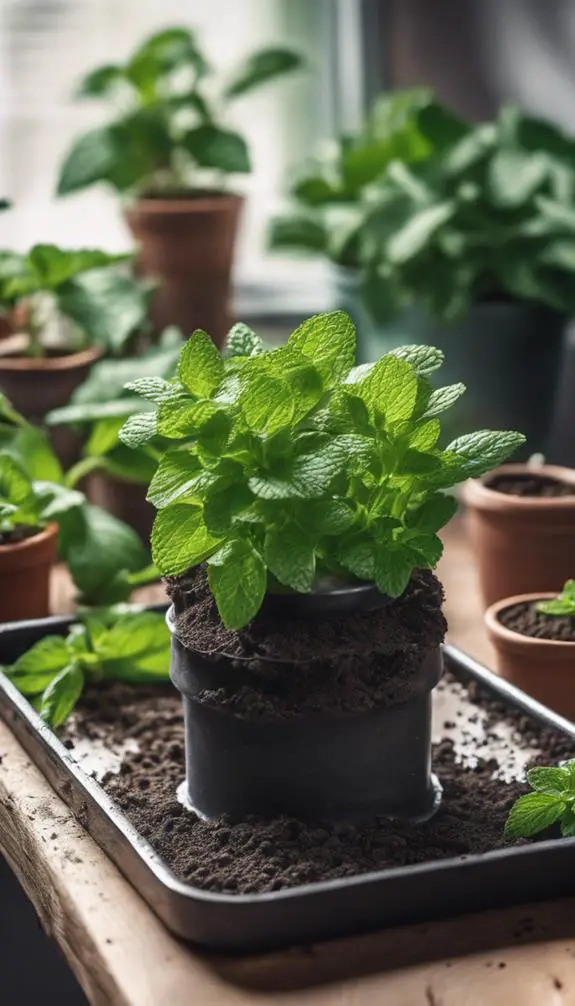
Several mint stems can be propagated from a single, healthy parent plant using cuttings.
You'll need to cut 3-5 inch stems from the parent plant, making sure each cutting has at least two sets of leaves. Remove lower leaves, leaving only the top two sets, and trim the stem just above a node.
Dip the cut end in rooting hormone to promote root growth. Plant the cutting in a pot filled with a well-draining mix, and water thoroughly. Keep the soil consistently moist, but not waterlogged.
With ideal mint propagation techniques, you can achieve high cutting success rates. Within 2-3 weeks, roots should develop, and new growth will emerge.
Transplant the new mint plants to individual pots or directly into the garden.
Harvesting Fresh Mint Leaves

After successfully propagating mint through cuttings, it's time to reap the rewards of your labor.
To harvest fresh mint leaves, focus on picking individual leaves or stems from the mint clusters. This encourages the plant to produce more growth and prevents it from flowering.
For fresh picking, pinch or cut off the top sets of leaves, just above a node, using scissors or pinch them off with your fingers. Take care not to damage the stems, as this can lead to disease and pest issues.
Regular harvesting will promote bushy growth and prevent the mint from becoming leggy. You can harvest mint leaves at any time, but the best flavor and aroma are achieved when picked in the morning, after the dew has dried.
Preserving Mint for Later Use
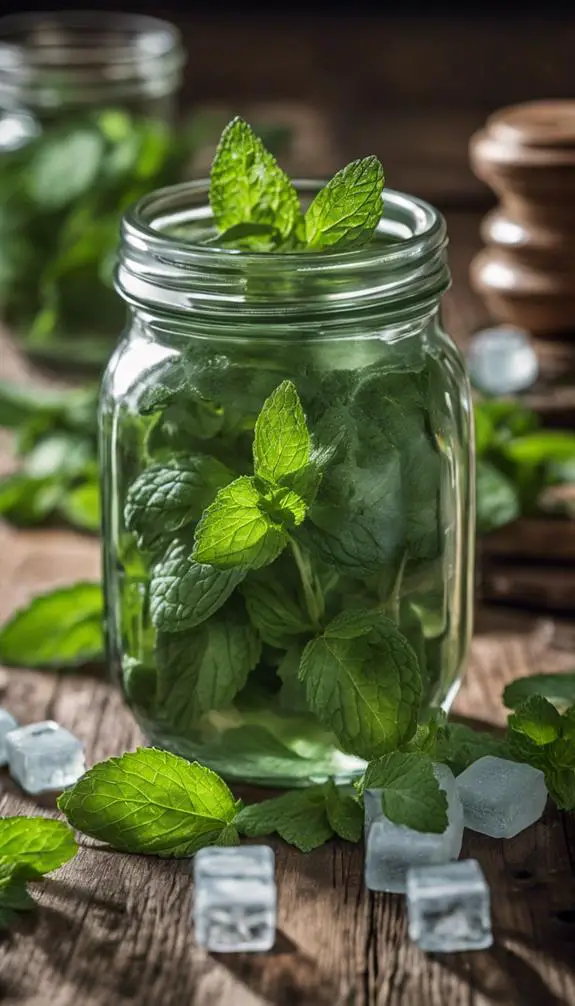
Your mint harvest is abundant, and you're enthusiastic to savor its freshness throughout the year.
To preserve mint for later use, you have two primary options: freezing mint and drying mint.
Freezing mint involves rinsing the leaves, patting them dry, and placing them in an airtight container or freezer bag. Frozen mint is ideal for teas, cocktails, and desserts.
Drying mint, on the other hand, involves tying the stems in small bunches and hanging them upside down in a warm, dry, dark place. Once dry, crumble the leaves into airtight containers for storage.
Dried mint is perfect for herbal teas, potpourri, and sachets. Both methods guarantee your mint stays fresh and flavorful for months to come.
FAQs
Can Mint Plants Be Grown Indoors Year-Round?
You can cultivate mint indoors year-round by recreating a favorable indoor climate, ensuring consistent temperatures between 65-75°F and high humidity, allowing for a winter harvest that's just as bountiful as a summer yield.
Will Mint Plants Attract Beneficial Insects to My Garden?
You'll attract beneficial buddies to your garden as mint plants serve as pollinator magnets, drawing in bees, butterflies, and hoverflies that facilitate pollination, while also luring predatory insects that prey on garden pests, creating a balanced ecosystem.
Can I Grow Mint in a Window Box or Vertical Garden?
When selecting a window box or vertical garden, you'll need to ponder window constraints, such as limited root depth, and sunlight limitations, ensuring your mint receives at least 4-6 hours of direct sunlight to thrive.
Is Mint Safe to Grow Around Pets and Small Children?
As a responsible pet owner, you'll want to know that mint can pose toxicity risks if ingested, so keep it out of reach of curious pets and small children to guarantee their safety and your peace of mind.
Can Mint Be Grown in Water or Hydroponically?
You can cultivate mint in water or hydroponically, leveraging fresh roots to maximize aquatic benefits. This method allows for precise control over nutrient intake, resulting in enhanced flavor and aroma, while reducing soil-borne diseases and pests.
Conclusion
You've successfully grown mint by choosing the right variety, preparing well-balanced soil, obtaining healthy plants, and providing consistent care. Regular pruning and harvesting will promote bushy growth and prevent overcrowding. With proper management of pests and diseases, you can enjoy fresh mint leaves throughout the growing season. Propagate mint through cuttings to share with friends or expand your crop. Finally, preserve mint for later use by drying, freezing, or making herbal teas and oils.


